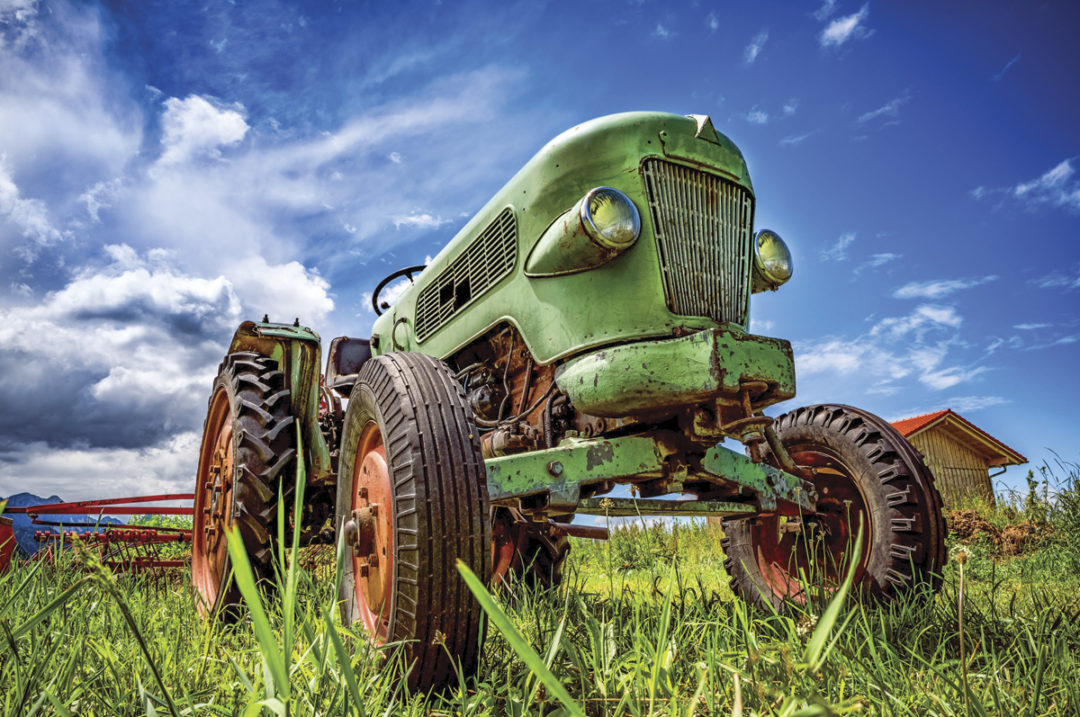If you enjoy machinery and the absolute wizardry of some people for bodywork and paint, then you may have considered what the pros and cons are of restoring an older but beloved vehicle, tractor, combine or implement in your shed or garage.
One of the obvious “cons” of restoration is the upfront cost of a show-quality finish. If you are looking at preserving a cherished family heirloom, then maybe this is further down the list. I can speak with some experience on this front.
My dad’s first tractor is in my “toybox” at the farm. It actually is his second tractor; he built his first one out of an old car, a truck rear end and belt pulley, which ran off the transmission. Its name must have been “Dangerous” because that is the most common word that came up when relatives recalled his creation.
Dad said it was handy because you could thrash oats at one farm, unhook the belt and drive 50 miles an hour to the next farm. (No wonder the family was happy about his decision to buy a “real” tractor.)
Now that it is mine and I have completely restored it, I have a story as well. I own a $1,000 tractor with a $10,000 paint job. OK, so it’s more like $2,000 and $9,250 but I think the point is still made.
While I wouldn’t have it any other way, one downside to my show-quality job is protecting the restoration as it and the tractor age. The tractor is now 71 and while it sees very little use other than starting and running onto the trailer for the next show, it still has the occasional mechanical issue that needs to be addressed.
At that point, protecting the fit and finish of the sheet metal is job No. 1, which brings up your first consideration – your use. If you want to use the tractor around the farm or if you want to wrench around with it, I suggest either doing a less expensive restoration or getting it mechanically safe and sound and leaving it in its “work clothes.”
Actually, leaving a patina is a popular trend at the moment. If you are wondering what the difference between dirt, rust and patina is, it’s somewhere between $100 and $1,000.
Speaking of cheaper, or perhaps more accurately, more affordable restorations, one descriptor that I have become aware of is “footer” as in “the paint job is a 15-footer.” What this refers to is that from 15 feet away, you can’t see the imperfections in the paint.
I have to admit, I chuckled when I first ran into this description. It makes sense, but I wonder whose eyesight is used as the measuring stick. (After cataract surgery on both eyes, the closer I get, the fewer imperfections I see.)
Still, there are options to at least consider when refinishing a project, especially a vehicle. You might look into wrapping as opposed to painting. Wrapping allows you to do some pretty nifty things with graphics and colors that might be more difficult with paint.
Wrapping can also be a less expensive option than painting. If you wish to repaint your truck, the old paint will need to be removed first for optimal results. Once the old paint has been removed, multiple coats will need to be applied and given time to dry, resulting in a costly and time-consuming process.
If you change your mind about the paint, you will need to repeat the process and try for a different color or design, further increasing costs. With vinyl wraps, no paint removal is required to alter the appearance of your vehicle. Instead, a vinyl wrap is directly installed on top of your current paint, preserving the original appearance of your vehicle beneath the vinyl. This allows you to easily remove the wrap if you decide that you are unhappy with it or if you change your company branding down the road.
Paint varies in durability based on the quality of the paint and how it was applied to the vehicle. While high-quality paint is durable, it requires significant washing and waxing to keep it looking great and free of chips or other imperfections.
The durability of vinyl will also vary based on the quality of the materials used, though most reputable car-wrap installers will only use high-quality materials like 3M vinyl. In terms of maintenance, vinyl wraps only require occasional cleaning with a cloth and soapy water to maintain their appearance and durability. This means that high-quality vinyl is as durable as high-quality paint while requiring less maintenance over time.
If you are deciding between painting or wrapping your truck, a vinyl wrap is a simple and easily reversible choice that often costs less than paint. This makes vinyl a great option for personal customization and business advertising alike.
Can wrap be repaired? Yes, but the ability to match colors and get the material blended in with the original calls for some skill on the part of the person doing the repair. Paint can have the same issues, but a minor paint flaw can be buffed out, which isn’t an option with wrap.
In the end, the most important critic of the project is you. You know what you like and what you don’t. One thing that is certain with any project is that more expensive and more gut-wrenching results come from trying to please everyone except yourself.








